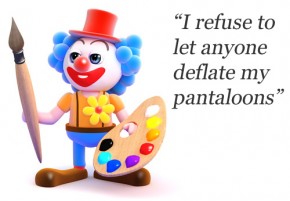It’s a jungle out there and now its time to engage in guerrilla warfare and hand-to-hand combat in order to sell your art direct to the public. Don’t like the analogy? Think all this art sales stuff should be all comfortable and snuggely like a warm blanket? Yes of course it should, for your customer at least, but for you this is serious, this is YOUR art business. So camo up, lock and load, we’re going over the top!
These golden rules were honed on the front line, selling my art myself, direct to the public at my own exhibitions. To do it successfully you have to be audacious. Shrinking violets should apply elsewhere.
Like any form of combat training or martial art the golden rules I am about to tell you will take practice, practice and more practice, and you can only practice by actually doing it. Be relentless, eventually you will experience the sweet taste of victory. So here we go…
Golden Rule No. 1: Greet, Retreat and then LOOK BUSY
When anyone walks into your exhibition space and takes more than a passing interest in your art, say “hello”, and maybe even a “how are you today?”, but not in a desperate “look at my art and then buy it pleeeeassee” way. YOU are a successful artist and you are busy, so GREET, RETREAT and LOOK BUSY. You want your prospective customer to feel welcomed and comfortable to stick around a while. They won’t do that if you are oggling their every move. Find something important looking to do like tapping on the computer keyboard fulfilling other sales (pretend or otherwise) or talking quietly on the phone to important sounding clients (again real or fictional…your choice). Look busy even if you are not! People have a herd mentality when buying art. If they get the impression that there is a stampede of people out there buying your art then they will be subconsciously reassured and more likely to move from art looker to art buyer.
Golden Rule No. 2: Display your battle victories
People seem to be absolutely fascinated by any artwork that has one of those red dots on it indicating that the painting is now SOLD. They will stare at these dots even more than the artwork itself for some strange reason. Maybe it’s just the colour attracting the eye. Maybe it’s the special aura around an artwork which someone else has deemed to be worthy by stumping up their hard earned cash. Red dots provide a cosseted reassurance that the ‘herd’ has already approved of your wild gesticulations on canvas or paper and that you and your art are the real deal. Here’s what to do:
- In a very obvious location in your exhibition hang a board on which you will display your sales victories.
- Stick the artwork details card (containing the title, size, medium and price) of artworks already sold on the sales board. Make sure each card has a big fat red dot.
- If you can, do everything in your power to sell at least two or three of the artworks that are intended for your show before the show opens so you can confidently claim victories on your sales board to get things rolling.
- As soon as any sale is made at the show, stick that big enticing red dot and details card on the board.
Adding up the amount of money an exhibition has taken by checking out the dots is a sport for some. I’ve actually witnessed people walk straight up to my art sales board and do the sums even before they looked at my artworks! Maybe I should just create artworks from fat red dots instead.
Golden Rule No. 3: Watch for Circling Sharks
Like a detective on a stake out, undertake discrete surveillance of what your exhibition visitors are doing. Stay busy but just keep a discrete eye on what’s happening. You’re on the lookout for ‘prospective buyer behaviour’. Prospective buyers tend to act differently from other exhibition visitors. Like sharks circling a prospective food source they hover around your artworks for longer than usual, and then quickly move up close for a quick snappy nibble to examine the artworks and take mental note of prices. Rarely will they decide to devour an artwork straight away by proclaiming “I’ll buy it now!”
If you notice this kind of behaviour then it’s time to just casually wander over and engage Mr or Mrs Shark in pleasant conversation. Quietly introduce yourself, ask where they are from or note something interesting about the artwork. Some people will put their defences up straight away, but maintain your pleasant composure and if necessary back off and leave them to their own devices. Many people will respond well, especially if you approach the encounter as genuinely wanting to meet a new shark (Oh dear I’ve now moved from a Guerrilla warfare analogy to a Jacques Cousteau Extreme Shark Encounter…oh well, if it works go with it).
Golden Rule No. 4. LISTEN!
Ego driven, self absorbed artists read the following carefully. When you are selling your art do not go banging on to potential customers about the underlying deep philosophical meanings of your artworks, and how during the creation of your artwork your soul was tortured due to memories resurfacing of the premature and untimely death of your budgie in the claws of a rabid bird of prey which flew off with the aforementioned budgie and then electrocuted itself on power lines. Don’t do that. Save it for interviews with editors of undecipherable art magazines later.
Instead, bring the conversation round to what the prospective buyer likes about the artwork. Get them to tell you about it and LISTEN! Don’t impose your thoughts about the artwork on them. Facilitate their getting to know the artwork for themselves. Let them have a chance to identify with it. Even though it’s your artwork, what it means to you is not important. IT’S ALL ABOUT WHAT IT MEANS TO THEM! By all means answer their questions about any aspect of your work but make sure that you are leading them back to what they like about it. Help them to make the connection between this artwork and their own life.
Golden Rule No. 5: Lead the sale
It’s always amazing to me how many people really don’t know what they want. Most people (not all) will fluff around all day and ultimately make no decision to buy at all after wasting hours of your time if you don’t lead the sale. To lead the sale effectively you need some inside information about your prospective client. Since I’ve been using a war analogy I could start painting a mental picture of a dark interrogation room with a single light bulb swinging as we extract the info we need, but since I have no wish to torture my clients I’ll leave that one alone.
Ask questions about where they’d like to hang your artwork; get them to describe the space. Guide them in visualising your artwork in their house by telling you where it will be situated. People LOVE to talk about themselves and their beautiful homes. Take an interest and a mental note of everything they are telling you. This is valuable information and it will help you guide the sale. If you can extract the information about what they like about your artwork and where it might eventually live in their home you have a powerful weapon in your art sales arsenal. Guide your potential client to zeroing in on just a couple of artworks based on what you are hearing, and how your artwork can fulfil THEIR needs. At all times just act as if this is a sale that is going ahead. Don’t fluff around saying ‘if’ and ‘maybe’ to a client. Be direct in your speech. More often than not there will be a point at which the client has a decision to make. To buy or not to buy, this painting or the other, or both.
When the time is right in the ebb and flow of things don’t be afraid to quickly reflect back to the client what they have said and how ‘this’ painting will fulfil their needs. For instance:
Client: “Oh I just can’t decide, both paintings are wonderful, but I’ve only got a small house and room for one”
You: “Well, you mentioned that the painting will be hanging over a blue lounge, so of the paintings that you like here I think this one would be absolutely beautiful in that spot, especially as it would echo that spectacular sea view from the opposite window.”
Client: (nodding and thinking): “Ah yes”
You: (in a matter of fact tone that infers this sale is going ahead): “So, would you like to take this painting home today?”
Important: NOW IT’S TIME TO SHUT UP. Do not say another word. If there is an awkward silence do not fill it. Rattling on any further will give the potential client room to wriggle out of making a decision right now. STAY QUIET. By asking the question and then staying silent they must make a decision.
At this point they will either:
COMMIT and indicate that they are genuinely interested in buying
SAY NO – people very rarely do this as it makes them feel awkward
DEFER and say “I’ll think about it and come back later” (which is a complete and utter lie designed to make them feel less awkward, but refreshingly just sometimes turns out to be true)
Okay, so we’re at the point of a client actually buying your artwork (or not as the case may be). Surely I can’t just leave you here like a bad soap opera cliff-hanger? Well yes, I can. This is turning into another long post so please subscribe to my feed and you’ll receive the next thrilling instalment as soon as I get in some more ranting time. 🙂
To be continued…












Thank you for your advices, I’m going to practice all of them this weekend in my first exhibition.
Loved the information. I am an artist in a working studio gallery…. I am trying to help my fellow artist determine how to identify thier market niche. Some of the artist are better communicators than others. Could you suggest a list of questions that I might put in a survey form that these artist could hand out to prospective collectors of thier work? Any other suggestions would be greatly appreciated. Thank you.
I’d just suggest asking for contact details, whether they would like to be invited to exhibitions, whether they are interested in purchasing original works, prints etc, and which of the works that are ‘on the walls’ are their favourites 🙂
Handed out at an exhibition, this information can make for enlightening reading when collated afterwards.
I am so glad I found your website! You are truthful, down to earth and I love your tactics.
Next weekend is my first art exhibit although I have painted all of my life; had another career.
Thanks so much. I am going to employ every single technique you mentioned. Kudos
Great tips for newbies and seasoned artists! Thanks!
Why didn’t I find your site before now? Guess I’ve been busy making paintings. I enjoy your sense of humour and practicl advice – still a shrinking violet though.Thanks for the great ideas.
Chris
Thanks Christine! 🙂
Thank you so much. Your suggestions are very helpful.
THANK YOU SO MUCH.
The best website ever! I have read so many books to try and help me, but your information is short, easy to understand and straight to the point. I have shared it with numerous other artist “strugglers”
Thanks v much.
I checked your website. Really Nice Birds and Bears! 🙂
I’d lose the giant copyright lettering thing though in favour of something a bit more subtle 😉
Thanks, Stuart for the advice and thanks for having a look at my website. It badly needs an update, but all in good time. LOL!!!!!!!
Great posts, very valuable information. I fell as though I am a people person, but still struggle going out and promoting my art. These short articles are great rules and advice that will hopefully give me the confidence to get out there.
I love your advice, I’ve been glued to your site for almost an hour at this point, and I still find more useful information with each page :). I’m a bit on the quiet side, which is something that constantly keeps me from being able to reach out and get people interested. I love the mini artfolio idea, and the tips on getting people interested is entertaining to read with the interesting analogies XD
Thanks so much, very informative and great advice. I am in sales so it was interesting to see how sales skills work within in art selling space